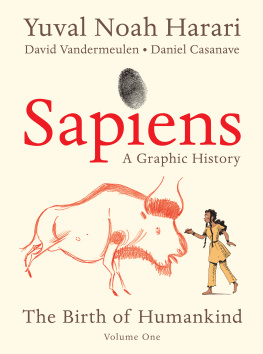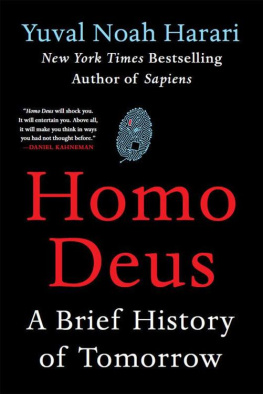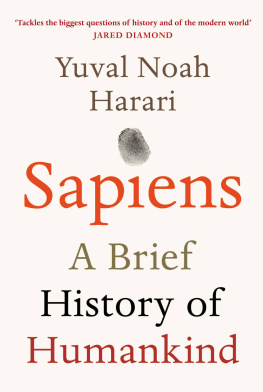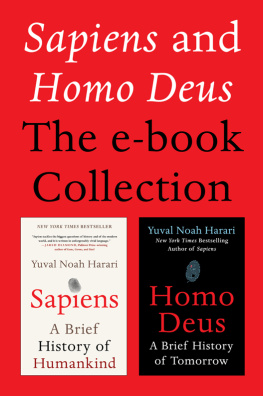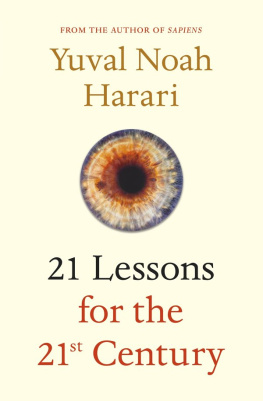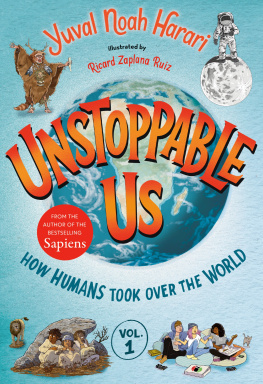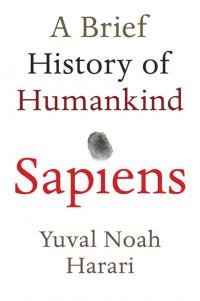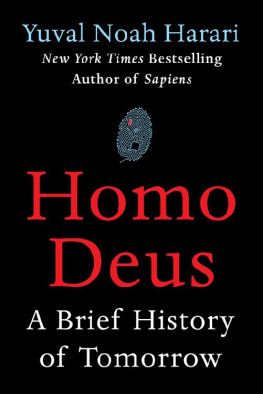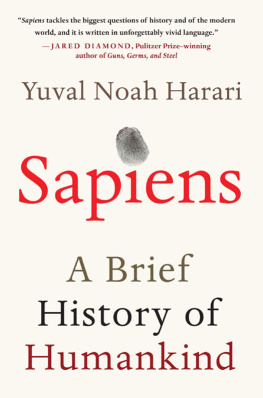Adapted under the coordination of Sapienship and Albin Michel
Publishing (France) from Sapiens: A Brief History of Humankind
by Yuval Noah Harari.
First published in Hebrew in 2011 by Kinneret, Zmora-Bitan, Dvir.
First English language edition published in 2020 by HarperCollins
Publishers.
SAPIENS: A GRAPHIC HISTORY, THE BIRTH OF HUMANKIND (VOL. ONE).
Copyright 2020 by Yuval Noah Harari. All rights reserved under International and
Pan-American Copyright Conventions. By payment of the required fees, you have
been granted the nonexclusive, nontransferable right to access and read the text of
this e-book on-screen. No part of this text may be reproduced, transmitted, downloaded,
decompiled, reverse-engineered, or stored in or introduced into any information storage
and retrieval system, in any form or by any means, whether electronic or
mechanical, now known or hereafter invented, without the express
written permission of HarperCollins e-books.
First U.S. edition
Cover design by Harold Peiffer
Cover illustration by Daniel Casanave
Creation and co-writing: Yuval Noah Harari
Adaptation and co-writing: David Vandermeulen
Adaptation and illustration: Daniel Casanave
Colors: Claire Champion
Editor (Albin Michel): Martin Zeller
Sapienship Storytelling:
Sponsorship and management: Itzik Yahav
Management and editing: Naama Avital
Editing and coordination: Naama Wartenburg
Master text translation: Adriana Hunter
Diversity consulting: Slava Greenberg
www.sapienship.co
Library of Congress Cataloging-in-Publication Data has been
applied for.
Digital Edition OCTOBER 2020 ISBN: 978-0-06-308794-1
Version 01122021
Print ISBN: 978-0-06-305133-1
To the extinct, the lost and the forgotten.
Everything that comes together is bound to be dissolved.
YUVAL NOAH HARARI
Timeline of History
Number of
years ago
13.8 billion
Matter and energy appear. Beginning of physics.
Formation of atoms and molecules. Beginning of chemistry.
4.5 billion
Formation of planet Earth.
3.8 billion
Emergence of organisms.
Beginning of biology.
6 million
Last common grandmother of humans and chimpanzees.
2.5 million
Humans evolve in Africa. First stone tools.
2 million
Humans spread from Africa to Eurasia.
Evolution of different human species.
500,000
Neanderthals evolve in Europe and the Middle East.
300,000
Daily usage of fire.
200,000
Homo sapiens evolves in Africa.
70,000
The Cognitive Revolution. Emergence of storytelling.
Beginning of history. Sapiens spread out of Africa.
50,000
Sapiens settle Australia. Extinction of Australian megafauna.
30,000
Extinction of Neanderthals. Homo sapiens the only surviving human
species.
16,000
Sapiens settle America. Extinction of American megafauna.
12,000
The Agricultural Revolution. Domestication of plants and animals.
5,000
First kingdoms, script and money. Polytheistic religions.
4,250
First empirethe Akkadian Empire of Sargon.
2,500
Invention of coinsa universal money.
The Persian Empirea universal political order.
Buddhism in Indiaa universal teaching.
2,000
Han Empire in China.
Roman Empire in the Mediterranean. Christianity.
1,400
Islam.
The Scientific Revolution. Humankind admits its ignorance and begins to
acquire unprecedented power.
Europeans begin to conquer America and the oceans. The entire planet
becomes a single historical arena. The rise of capitalism.
The Industrial Revolution. Family and community are replaced by state
and market. Massive extinction of plants and animals.
The Present
Humans transcend the boundaries of planet Earth.
Nuclear weapons threaten the survival of humankind.
Organisms are increasingly shaped by intelligent design rather than
natural selection.
The Future
Intelligent design becomes the basic principle of life?
First non-organic life-forms?
Humans become gods?
rebels of
the Savannah
About 14 billion years ago, matter,
energy, time and space came into being
in what is known as the Big Bang.
The story of these
fundamental features
of our universe is
called physics.
About 300,000 years after their
appearance, matter and energy
started to coalesce into complex
structures we call atoms.
These atoms then
combined into molecules.
The story of atoms, molecules and their
interactions is called chemistry.
Almost four billion years ago, on a planet known as
Earth, certain molecules combined to form particularly
large and intricate structures we call organisms.
The story of organisms is called biology.
And then, about 70,000 years ago, a particular type
of organismhuman beingsstarted to form even
more elaborate structures we call cultures.
The development of these human
cultures is called history.
Sorry, I havent even
introduced myself!
Hi. My names Yuval
Noah Harari.
I know, Historians dont usually
talk about physics, chemistry
and biology...
They usually talk
about stuff like
the French
Revolution.
Im a
historian.
But human history
is actually a direct
continuation of physics...
chemistry...
and biology.
We cant understand things like the
French Revolution until we understand
how humans evolved.
Humans are animals, and everything
that has happened in history
has obeyed the laws of physics,
chemistry and biology.
There were human beings long
before there was history. The
first humans evolved right
here, in East Africa.
2.5 million years ago
See that little
group over there?
Theyre our
ancient
ancestors.
Their behavior looks kind of
familiar, dont you think?
But they werent
very different
from gorillas...
elephants...
or birds.
The truth is there was nothing special about
these early humans. They were still regular
animals with no more impact on their environment
than baboons, fireflies or jellyfish. There was no
sign that one day they would conquer and
transform the whole world...
This book will explain why things
did not work out that way...
Thats one small step
for a hippo, one giant
leap for mammals.
One very important thing about ancient humans is
they didnt all belong to the same species.
Nowadays, people around the world may look
different and speak different languages, but
were all the same speciesHomo sapiens.
Which is surprising... After all, there are different species of ants, snakes and
bears... So why shouldnt there be different species of humans?
In fact, until about 50,000
years ago, our planet
was home to at least six
different species of humans.
One Lilliput-like island was
inhabited by a species of
dwarves...
ding
dong!
Excuse me!
Someones at
the door.
Hi Uncle Yuval!
Zoe! Perfect
timing! Ive got
something to
show you.
A card game?
That looks
fun! Can we
play?
Sure we can!
just wait, youre
gonna love it!
Who
can
that
be?
hominins
Fascinating, isnt it?
Yes, we know that for sure. We all
belong to the same species.
How can we be so sure?
But, Uncle Yuval,
are you totally sure
all those other
human species died
out and were all
Homo sapiens now?
Wherever you
go today, to
France, Senegal,
Australia or
Greenland, youll

